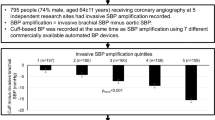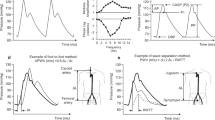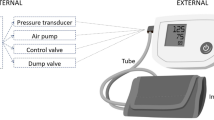Abstract
Mean arterial pressure (MAP) is often estimated from cuff systolic (S) and diastolic (D) blood pressure (BP) using a fixed arterial form factor (FF, usually 0.33). If MAP is measured directly, a true FF can be calculated: FF = [MAP–DBP]/[SBP–DBP]. Because waveform shapes vary, true FF should also vary and MAP accuracy will be affected. We studied factors affecting FF using radial tonography (SphygmoCor, n = 376) or brachial oscillometry (Mobil-O-Graph, n = 157) and to compare devices, 101 pairs were matched precisely for SBP and DBP. SphygmoCor brachioradial FF correlated strongly with central FF (r2 = 0.75), central augmentation index (cAI, r2 = 0.39), and inversely with pulse pressure amplification (PPA) ratio (r2 = 0.44) [all p < 0.000]; brachioradial FF was lower than central (c) FF (0.34 vs. 0.44, 95% CI’s [0.23,0.46] and [0.34,0.54], p < 0.000). On forward stepwise regression, brachioradial FF correlated with PPA ratio, age, heart rate, and cAI (multiple-r2 0.63, p < 0.000). With Mobil-O-Graph: brachial FF was fixed, lower than the corresponding cFF [mean(SD)] 0.46(0.00098) vs. 0.57(0.048), p < 0.000], and uncorrelated with clinical characteristics; MAP and cSBP were higher than SphygmoCor by 6.3 and 2.2 mmHg (p < 0.005) at the midpoint with systematic negative biases. We conclude that FF derived from radial tonometry (SphygmoCor) varies with pulse wave morphology within and between individuals and by measurement site, age, and heart rate. With oscillometry (Mobil-O-Graph), brachial FF was fixed and high and unrelated to other clinical variables; MAP and cSBP were higher than tonometry, with systematic negative biases.
This is a preview of subscription content, access via your institution
Access options
Subscribe to this journal
Receive 12 digital issues and online access to articles
$119.00 per year
only $9.92 per issue
Buy this article
- Purchase on Springer Link
- Instant access to full article PDF
Prices may be subject to local taxes which are calculated during checkout



Similar content being viewed by others
Data availability
Data are available from the author upon request.
References
Schultz MG, Picone DS, Armstrong MK, Black JA, Dwyer N, Roberts-Thomson P, et al. The influence of SBP amplification on the accuracy of form-factor-derived mean arterial pressure. J Hypertens. 2020;38:1033–9.
Wilkinson IB, Mohammad NH, Tyrrell S, Hall IR, Webb DJ, Paul VE, et al. Heart rate dependency of pulse pressure amplification and arterial stiffness. Am J Hypertens. 2002;15:24–30.
Wilkinson IB, MacCallum H, Hupperetz PC, van Thoor CJ, Cockcroft JR, Webb DJ. Changes in the derived central pressure waveform and pulse pressure in response to angiotensin II and noradrenaline in man. J Physiol. 2001;530:541–50.
Jedrzejewski D, McFarlane E, Lacy P, Williams B. Pulse wave calibration and implications for blood pressure measurement: systematic review and meta-analysis. Hypertension (Dallas, Tex: 1979) 2021;78:360–71.
Kelly R, Hayward C, Avolio A, O’Rourke M. Noninvasive determination of age-related changes in the human arterial pulse. Circulation 1989;80:1652–9.
Wassertheurer S, Kropf J, Weber T, van der Giet M, Baulmann J, Ammer M, et al. A new oscillometric method for pulse wave analysis: comparison with a common tonometric method. J Hum Hypertens. 2010;24:498–504.
Sharman JE, O’Brien E, Alpert B, Schutte AE, Delles C, Hecht Olsen M, et al. Lancet Commission on Hypertension group position statement on the global improvement of accuracy standards for devices that measure blood pressure. J Hypertens. 2020;38:21–9.
Karamanoglu M, O’Rourke MF, Avolio AP, Kelly RP. An analysis of the relationship between central aortic and peripheral upper limb pressure waves in man. Eur Heart J. 1993;14:160–7.
Wassertheurer S, Mayer C, Breitenecker F. Modeling arterial and left ventricular coupling for non-invasive measurements. Simul Model Pract Theory. 2008;16:988–97.
Verbeke F, Segers P, Heireman S, Vanholder R, Verdonck P, Van Bortel LM. Noninvasive assessment of local pulse pressure: importance of brachial-to-radial pressure amplification. Hypertension (Dallas, Tex: 1979) 2005;46:244–8.
Armstrong MK, Schultz MG, Picone DS, Black JA, Dwyer N, Roberts-Thomson P, et al. Brachial and Radial Systolic Blood Pressure Are Not the Same. Hypertension (Dallas, Tex: 1979) 2019;73:1036–41.
Izzo JL, Anwar MA, Elango K, Ahmed R, Osmond P. Decoupling of Heart Rate and Blood Pressure: Hemodynamic Counter-regulatory Mechanisms and their Implications. Artery Res. 2019;25:87–94.
Segers P, Mahieu D, Kips J, Rietzschel E, De Buyzere M, De Bacquer D, et al. Amplification of the pressure pulse in the upper limb in healthy, middle-aged men and women. Hypertension (Dallas, Tex: 1979) 2009;54:414–20.
Adji A, O’Rourke MF. Brachial artery tonometry and the Popeye phenomenon: explanation of anomalies in generating central from upper limb pressure waveforms. J Hypertens. 2012;30:1540–51.
Papaioannou TG, Protogerou AD, Vrachatis D, Konstantonis G, Aissopou E, Argyris A, et al. Mean arterial pressure values calculated using seven different methods and their associations with target organ deterioration in a single-center study of 1878 individuals. Hypertens Res. 2016;39:640–7.
Laurent P, Albaladejo P, Blacher J, Rudnichi A, Smulyan H, Safar ME. Heart rate and pulse pressure amplification in hypertensive subjects. Am J Hypertens. 2003;16:363–70. 5 Pt 1
Sharman JE, Davies JE, Jenkins C, Marwick TH. Augmentation index, left ventricular contractility, and wave reflection. Hypertension (Dallas, Tex: 1979) 2009;54:1099–105.
Wassertheurer S, Hametner B, Mayer CC, Hafez A, Negishi K, Papaioannou TG, et al. Aortic systolic pressure derived with different calibration methods: associations to brachial systolic pressure in the general population. Blood Press Monit. 2018;23:134–40.
Schwartz JE, Feig PU, Izzo JL Jr. Pulse Wave Velocities Derived From Cuff Ambulatory Pulse Wave Analysis. Hypertension (Dallas, Tex: 1979) 2019;74:111–6.
Drzewiecki GJ, Bansal V, Karam K, Hood R, Apple H. Mechanics of the occlusive arm cuff and its application as a volume sensor. IEEE Trans Biomed Eng. 1993;40:704–8.
Baker PD, Westenskow DR, Kück K. Theoretical analysis of non-invasive oscillometric maximum amplitude algorithm for estimating mean blood pressure. Med Biol Eng Comput. 1997;35:271–8.
Chandrasekhar A, Yavarimanesh M, Hahn JO, Sung SH, Chen CH, Cheng HM, et al. Formulas to Explain Popular Oscillometric Blood Pressure Estimation Algorithms. Front Physiol. 2019;10:1415.
Jones CR, Taylor K, Chowienczyk P, Poston L, Shennan AH. A validation of the Mobil O Graph (version 12) ambulatory blood pressure monitor. Blood Press Monit. 2000;5:233–8.
Izzo JL, Mitchell GF. Pitfalls of Pulse Wave Analysis and Oscillometric Blood Pressure Derivatives. Hypertension (Dallas, Tex: 1979) 2021;78:372–5.
Vos J, Vincent HH, Verhaar MC, Bos WJW. Inaccuracy in Determining Mean Arterial Pressure With Oscillometric Blood Pressure Techniques. Am J Hypertens. 2013;26:624–9.
Rogers G, Oosthuyse T. A comparison of the indirect estimate of mean arterial pressure calculated by the conventional equation and calculated to compensate for a change in heart rate. Int J Sports Med. 2000;21:90–5.
Mitchell GF, Wang N, Palmisano JN, Larson MG, Hamburg NM, Vita JA, et al. Hemodynamic correlates of blood pressure across the adult age spectrum: noninvasive evaluation in the Framingham Heart Study. Circulation. 2010;122:1379–86.
Ting CT, Chen CH, Chang MS, Yin FC. Short- and long-term effects of antihypertensive drugs on arterial reflections, compliance, and impedance. Hypertension (Dallas, Tex: 1979) 1995;26:524–30.
Acknowledgements
This work was presented in part at the European Society of Hypertension meeting in 2022.
Funding
This work was supported in part by a grant from the Research in Erie County Foundation.
Author information
Authors and Affiliations
Contributions
JI was responsible for overall supervision, including conceptualizing the study, analyzing the data, and writing the paper. DM, SN, and PO contributed to the data analysis.
Corresponding author
Ethics declarations
Competing interests
The authors declare no competing interests.
Additional information
Publisher’s note Springer Nature remains neutral with regard to jurisdictional claims in published maps and institutional affiliations.
Rights and permissions
Springer Nature or its licensor (e.g. a society or other partner) holds exclusive rights to this article under a publishing agreement with the author(s) or other rightsholder(s); author self-archiving of the accepted manuscript version of this article is solely governed by the terms of such publishing agreement and applicable law.
About this article
Cite this article
Izzo, J.L., Mukhopadhyay, D., Nagpal, S. et al. Impact of arterial location, pressure wave indicators, and measurement devices on arterial form factor and mean and central arterial pressure. J Hum Hypertens 37, 891–897 (2023). https://doi.org/10.1038/s41371-022-00791-w
Received:
Revised:
Accepted:
Published:
Issue Date:
DOI: https://doi.org/10.1038/s41371-022-00791-w



